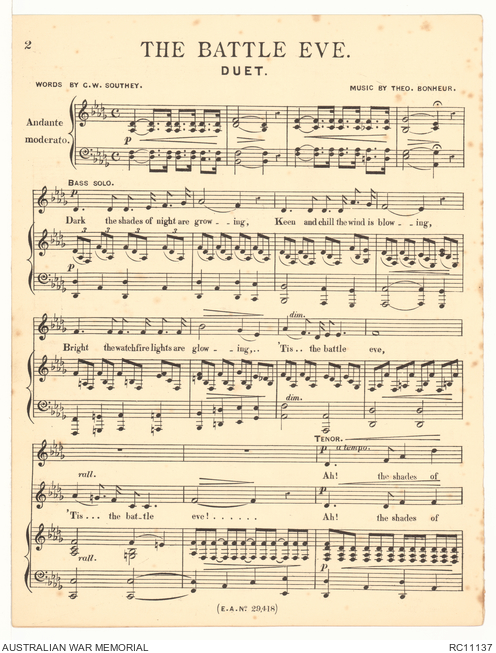| Accession Number | RC11137 |
|---|---|
| Collection number | Sheet Music Collection 652 |
| Collection type | Published Collection |
| Record type | Item |
| Item count | 1 |
| Measurement | Overall - closed: 31.3 cm x 24.1 cm |
| Object type | Sheet Music |
| Maker |
Bonheur, Theo Southey, G.W. |
| Place made | United Kingdom, United Kingdom: England |
| Date made | c 1890-1899 |
| Conflict |
First World War, 1914-1918 Period 1890-1899 |
| Copying Provisions | Digital format and content protected by copyright. |
[Sheet music] The Battle Eve : Duet for Tenor and Bass












Sheet music for the duet titled 'The Battle Eve' composed by Theo Bonheur with lyrics written by G W Southey. The song has been written for performances by bass and tenor voices. The front cover of this copy of the sheet music for this song shows that it was published by the British publishing firm, Edwin Ashwon Limited, London, and was sold for 2/-. The back cover of this copy features a list of songs that were available for purchase and regarded as Ashdown's successful standards. These include titles by composers such as Arthur Sullivan and Gustav Holst.
The piece appears to have been composed in the early 1890s with the first recorded performance at the Athenaeum in Melbourne in May 1893.
Theo Bonheur was the pseudonym used by the British composer Arthur Charles Rawlings, known as Charles, who was taught to play piano by his father. His father, also named Arthur Charles Rawlings, was a piano tuner and had been blind since birth. It is believed that Charles Rawlings started using a pseudonym after failing to get compositions published under his birth name.
Gautier Leonard Southey was a French composer and appears to have been the writer of the lyrics for this song. He composed a piano piece titled 'Le Secret' as well as waltzes like 'The Fairy Wand Waltz' which was written during 1893.
Towards the bottom of this page is a sound recording of this sheet music, or a parody, that was created as part of the Music and the First World War project. More information about this recording, including names of the performers, can be found on the catalogue record for the sound recording. A link to the catalogue record for the sound recording can be found at the bottom of this page, under the heading ‘Related objects’ where it can be identified with the prefix [sound recording].
- Download PDF document of [Sheet music] The Battle Eve : Duet for Tenor and Bass (file)
-
Listen to
[Sheet music] The Battle Eve : Duet for Tenor and Bass
Share this page
Related information
Subjects
People
Related Objects
- [Concert program] Item 10: Australian Flying Corps (Minchinhampton Aerodrome) Concert Party
- [Concert program] Item 3: The Fragments
- [Concert program] Item 3: Grand concert
- [Concert program] Item 25: Entertainment in aid of the funds of the Royal Merchant Seamen's Orphanage.
- [Concert program] Item 28: A grand concert
- [Concert program] Item 1: Programme Sunday May 19, 1918.
- [Concert program] Item 25: The 'Coo-ees'
- [Concert program] Item 26: The 'Coo-ees'
- [Concert program] Item 27: The 'Coo-ees'
- [Sound recording] The Battle Eve